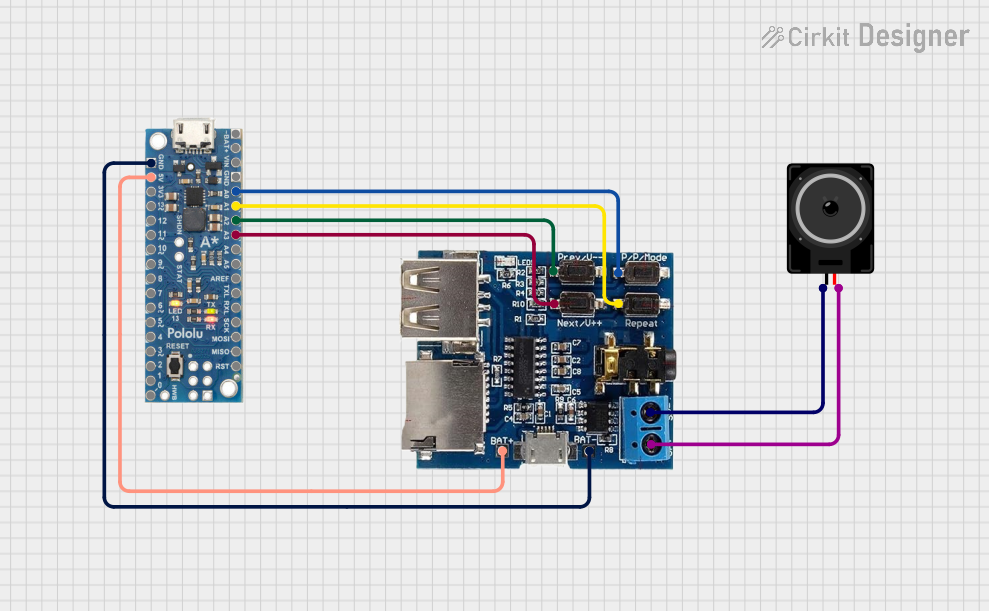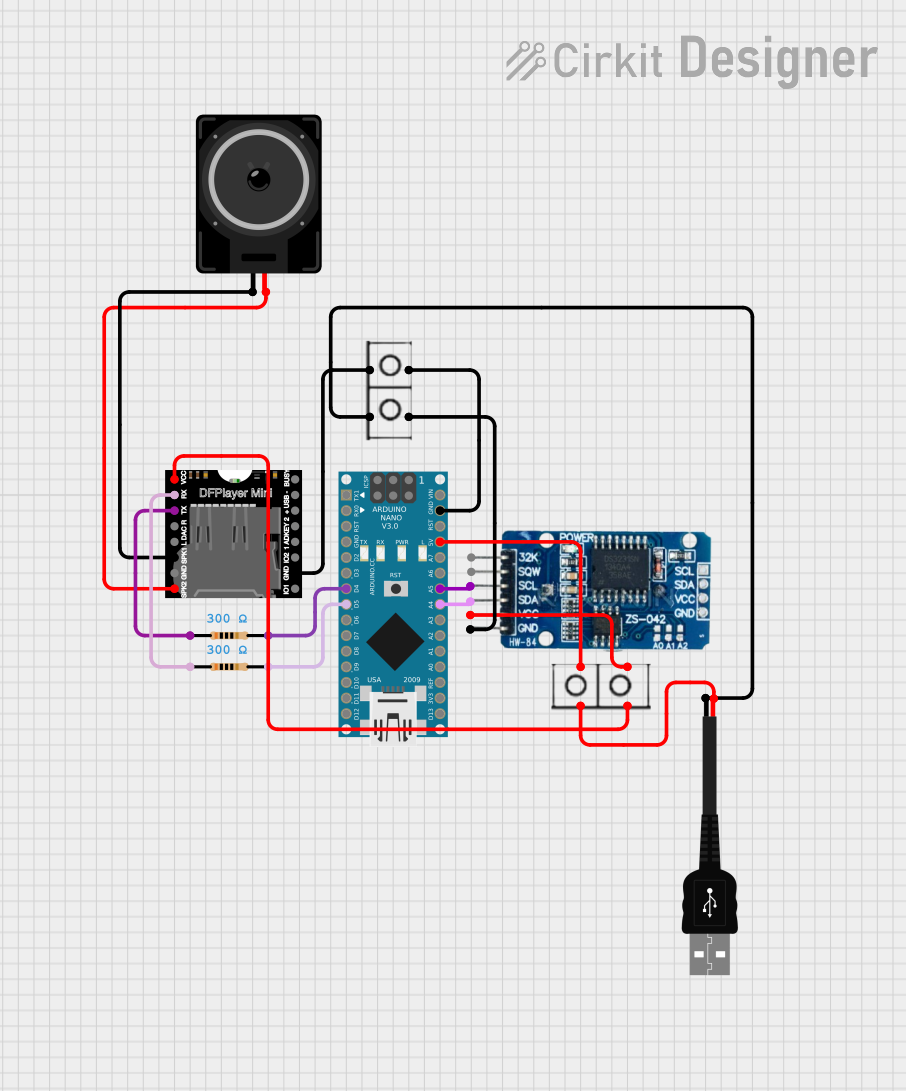
How to Use Serial mp3 player: Examples, Pinouts, and Specs

 Design with Serial mp3 player in Cirkit Designer
Design with Serial mp3 player in Cirkit DesignerIntroduction
The Serial MP3 Player is an electronic component designed to add audio playback capabilities to microcontroller projects. It can play MP3 audio files stored on a microSD card and is controlled via serial commands, making it compatible with a wide range of microcontrollers, including Arduino, Raspberry Pi, and others. Common applications include voice announcements, musical projects, and creating sound effects for various interactive installations.
Explore Projects Built with Serial mp3 player

 Open Project in Cirkit Designer
Open Project in Cirkit Designer
 Open Project in Cirkit Designer
Open Project in Cirkit Designer
 Open Project in Cirkit Designer
Open Project in Cirkit Designer
 Open Project in Cirkit Designer
Open Project in Cirkit DesignerExplore Projects Built with Serial mp3 player

 Open Project in Cirkit Designer
Open Project in Cirkit Designer
 Open Project in Cirkit Designer
Open Project in Cirkit Designer
 Open Project in Cirkit Designer
Open Project in Cirkit Designer
 Open Project in Cirkit Designer
Open Project in Cirkit DesignerTechnical Specifications
Key Technical Details
- Supported Formats: MP3, WAV
- Voltage Supply: 3.2V to 5.25V
- Output Power: Up to 3W (when connected to a 4-ohm speaker)
- Communication: Serial UART, 9600 bps by default
- Storage: microSD card (FAT16 or FAT32 format, up to 32GB)
Pin Configuration and Descriptions
| Pin Number | Name | Description |
|---|---|---|
| 1 | VCC | Power supply (3.2V to 5.25V) |
| 2 | GND | Ground connection |
| 3 | TX | Transmit pin, connects to RX of the microcontroller |
| 4 | RX | Receive pin, connects to TX of the microcontroller |
| 5 | SPK1 | Speaker output 1 |
| 6 | SPK2 | Speaker output 2 |
Usage Instructions
Connecting to a Microcontroller
- Connect the VCC pin to the 5V output on the microcontroller.
- Connect the GND pin to the ground on the microcontroller.
- Connect the TX pin of the MP3 player to the RX pin of the microcontroller.
- Connect the RX pin of the MP3 player to the TX pin of the microcontroller.
- Connect a speaker to the SPK1 and SPK2 pins.
Important Considerations and Best Practices
- Ensure that the power supply is within the specified voltage range to prevent damage.
- Format the microSD card to FAT16 or FAT32 and ensure that MP3 files are properly named and placed in the root directory.
- Use a level shifter if the microcontroller operates at a different logic level than the MP3 player.
- Keep the serial communication lines as short as possible to reduce noise.
Example Code for Arduino UNO
#include <SoftwareSerial.h>
// RX and TX connected to pins 10 and 11 on the Arduino
SoftwareSerial mySerial(10, 11);
void setup() {
// Start the serial communication
mySerial.begin(9600);
Serial.begin(9600);
// Send a command to the MP3 player to play the first track
playTrack(1);
}
void loop() {
// Additional code to control the MP3 player can be added here
}
// Function to play a specific track
void playTrack(int trackNumber) {
// Command format for the MP3 player
mySerial.write(0x7E); // Starting byte
mySerial.write(0xFF); // Version
mySerial.write(0x06); // Length
mySerial.write(0x03); // Command (0x03 for play)
mySerial.write(0x00); // Feedback (0x00 no, 0x01 yes)
mySerial.write((uint8_t)(trackNumber >> 8)); // Track number high byte
mySerial.write((uint8_t)(trackNumber)); // Track number low byte
mySerial.write(0xEF); // Ending byte
}
// Remember to wrap comments to limit line length to 80 characters
Troubleshooting and FAQs
Common Issues
- No Audio Output: Ensure the speaker is properly connected and functional. Check the volume level and the file format on the microSD card.
- Serial Communication Failure: Verify the wiring between the MP3 player and the microcontroller. Ensure that the baud rate matches the MP3 player's default or configured rate.
Solutions and Tips for Troubleshooting
- If the MP3 player is unresponsive, try resetting the power supply.
- For noise issues, use shielded cables for the speaker connections and keep the serial lines short.
- Update the firmware of the MP3 player if available to ensure compatibility with newer microSD cards.
FAQs
Q: Can I connect multiple speakers to the MP3 player? A: Yes, you can connect two speakers to the SPK1 and SPK2 outputs for stereo sound.
Q: How do I change the volume? A: Send a serial command to adjust the volume. Refer to the MP3 player's command set for the specific command format.
Q: What is the maximum size of the microSD card that I can use? A: The MP3 player supports microSD cards up to 32GB in size.
Q: Can I power the MP3 player with a battery? A: Yes, as long as the battery voltage is within the specified range (3.2V to 5.25V).